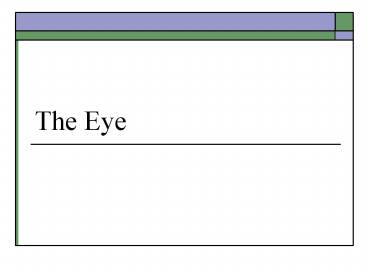The Eye PowerPoint PPT Presentation
1 / 11
Title: The Eye
1
The Eye
2
A Model for Sensing
- Three components
- Stimulus detection a specialized sensory neuron
- Reception where neurons receive information
from the sensory neurons - Integration where information from receivers is
processed - All the human sensory systems have these
components.
3
The Visual System
- Retina
- Optic nerve (axons of ganglia in eye)
- Layers in the thalamus (LGN)
- Secondary paths to SCN (circadian rhythms) and
superior colliculi to control eye movement - Primary visual cortex
4
Adaptation
- Adaptation -- diminishing receptiveness of a
sensory receptor neuron. - Habituation also diminishing receptiveness but
at a different level (within a neuronal circuit
not a cell). - Adaptation is essential for the perception of
change. - Dark and light adaptation permit vision under
different environmental conditions.
5
Parts of the Eye
- Cornea protects eye and initiates focusing
- Lens focuses light on the appropriate spot on
the retina - Iris adjusts focus by opening and closing pupil
to admit light - Pupil hole that admits light
6
More Parts of the Eye
- Aqueous and vitreous humor fluid inside eye
- Sclera whites of eye
- Retina layer of photoreceptors at the back of
the eye, responsive to light - Blind spot place where optic nerve exits the
eye - Fovea spot of best focus and densest cones
7
Types of Photoreceptors
- Rods used for brightness perception and motion
- Cones used for color and form (shape)
perception - Cones are wavelength-specific
- Blue 430 nm
- Green 530 nm
- Red 560 nm
- Mixing all three equally produces white
8
Transduction
- Photoreceptors release the neurotransmitter
glutamate (glu) when depolarized. - Depolarized in the dark.
- Hyperpolarized by light.
- Only ganglion cells have action potentials.
- Photoreceptors produce graded response that
provides input aggregated by bipolar cells. - Magno ganglion cells receive input from rods,
parvo ganglion cells from cones
9
Bipolar Cell Receptive Fields
- The receptive field is the area of the retina
capable of changing the bipolar cells membrane
potential - Two kinds of receptive fields
- OFF cell excitatory
- ON cell inhibitory
- OFF and ON refers to light, not the cell
- Center and surround are opposites
10
Edge Detection
- The center-surround organization of the receptive
fields of ganglion cells exaggerates the contrast
at borders. - Visual processes fill in what occurs between
borders (edges). - Contrast effects occur because we notice
variations, not absolute magnitudes of light.
11
Color Contrast
- Cones respond to specific wavelengths of light
that determine hue. - Color cells have complementary surrounds that
heighten contrast and strengthen their signal. - Opponents are red/green, blue/yellow.

